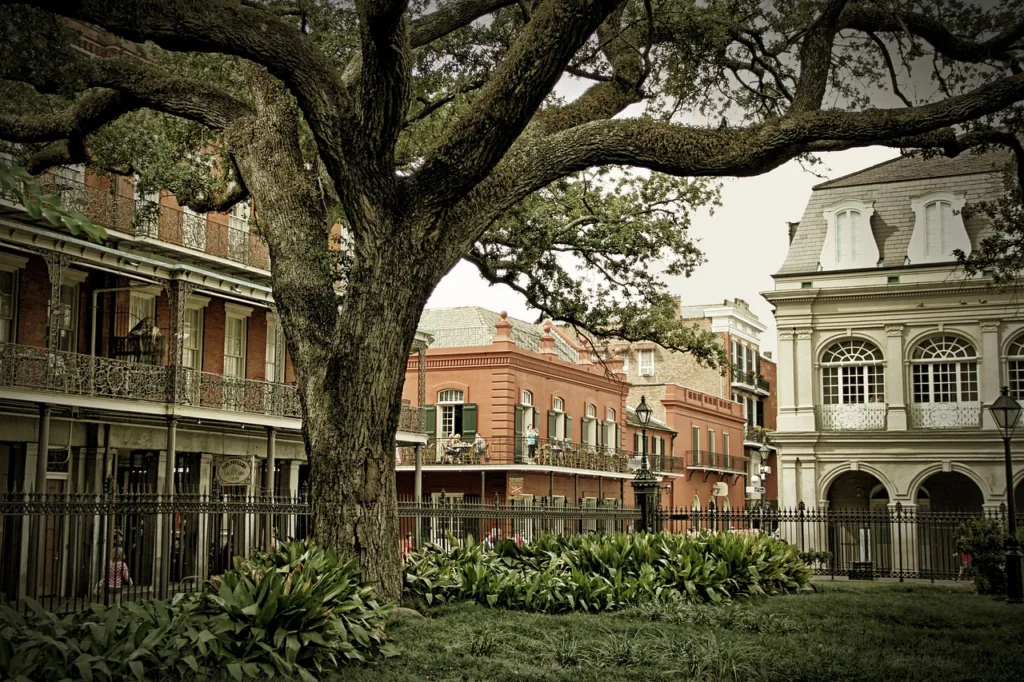New Orleans experiences a subtropical climate, characterized by hot, humid summers and mild, wet winters. The city is located near the Gulf of Mexico, which significantly influences its weather patterns. Consequently, the summers are long, stretching from May to September, and are often punctuated by afternoon thunderstorms. Additionally, the winters are brief, with temperatures rarely dropping below freezing.

Average Temperatures in New Orleans
In summer, temperatures in New Orleans typically hover around the high 80s to low 90s Fahrenheit (30-35 degrees Celsius). However, the humidity can make it feel much hotter, with heat indices often exceeding 100 degrees Fahrenheit (38 degrees Celsius). Conversely, winter temperatures are generally mild, with averages ranging from the mid-40s to mid-60s Fahrenheit (7-18 degrees Celsius).
New Orleans Rainfall and Humidity
Rainfall is relatively evenly distributed throughout the year in New Orleans, with an annual average of approximately 62 inches (157 cm). The city is known for its high humidity levels, particularly during the summer months. This can make the heat feel more oppressive and lead to a higher chance of afternoon thunderstorms.

Hurricane Season in New Orleans
One of the key factors to consider when discussing New Orleans weather is the hurricane season, which runs from June 1 to November 30. The city’s location along the Gulf Coast makes it susceptible to tropical storms and hurricanes. Residents and visitors alike should remain vigilant during this period and monitor weather advisories for any potential threats.
Best Time to Visit New Orleans
The best time to visit New Orleans is during the spring (March to May) or fall (October to November) when the weather is mild, and the city is alive with festivals and events. During these months, temperatures are comfortable, and rainfall is moderate, making it ideal for outdoor activities and exploring the city’s rich cultural heritage.

Conclusion
In summary, New Orleans offers a unique weather experience, with hot and humid summers, mild winters, and a significant amount of rainfall throughout the year. Whether you’re planning a trip or just curious about the climate, understanding the weather patterns in New Orleans can enhance your overall experience in this vibrant and historic city.
Similar Articles
FAQs About the Weather in New Orleans
1. What is the weather like in New Orleans during the summer?
Summer in New Orleans is characterized by hot and humid conditions. Temperatures often hover around the high 80s to low 90s Fahrenheit (30-35 degrees Celsius), and the humidity can make it feel even hotter.
2. Does it snow in New Orleans in the winter?
Snow is a rare occurrence in New Orleans. Winters are typically mild, with temperatures ranging from the mid-40s to mid-60s Fahrenheit (7-18 degrees Celsius). The city rarely experiences freezing temperatures or snowfall.
3. What is the average annual rainfall in New Orleans?
New Orleans receives an average annual rainfall of approximately 62 inches (157 cm). Rainfall is relatively evenly distributed throughout the year, with no particularly dry season.
4. How often do hurricanes affect New Orleans?
New Orleans is located along the Gulf Coast and is susceptible to tropical storms and hurricanes. Hurricane season runs from June 1 to November 30, and residents and visitors should monitor weather advisories during this period for any potential threats.
5. What is the best time to visit New Orleans for good weather?
The best time to visit New Orleans for favorable weather conditions is during the spring (March to May) or fall (October to November). During these months, temperatures are comfortable, and rainfall is moderate, making it ideal for outdoor activities and exploring the city.
6. Is there a rainy season in New Orleans?
While rainfall is relatively evenly distributed throughout the year, New Orleans can experience heavier rainfall during the summer months due to the high humidity and the potential for afternoon thunderstorms.
7. What should I wear when visiting New Orleans in the summer?
Given the hot and humid conditions, it’s advisable to wear light, breathable clothing when visiting New Orleans in the summer. Pack light-colored, loose-fitting clothes, a wide-brimmed hat, sunglasses, and sunscreen to stay comfortable and protected from the sun.
8. What is the humidity level like in New Orleans?
New Orleans is known for its high humidity levels, particularly during the summer months. The humidity can make the heat feel more oppressive and can contribute to the occurrence of afternoon thunderstorms.
9. Should I be concerned about hurricanes when planning a trip to New Orleans?
While hurricanes can pose a threat to New Orleans, the city is well-prepared for such events. If you’re planning to visit during hurricane season (June to November), it’s advisable to monitor weather advisories and have a contingency plan in place.
10. How does the weather in New Orleans compare to other cities in the United States?
New Orleans has a subtropical climate, which is characterized by hot, humid summers and mild, wet winters. This contrasts with cities in the northern United States, which experience colder winters, and cities in the southwestern United States, which have hotter, drier climates.









